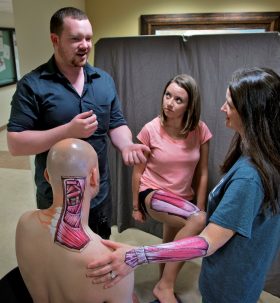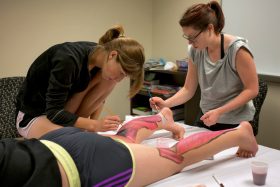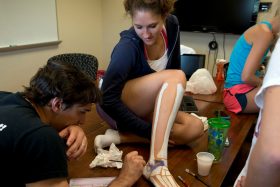Graduate students in Elon's Doctor of Physical Therapy and Physician Assistant Studies programs worked July 11 with a nationally recognized artist to paint muscles, tissue and bone onto classmates in a hands-on approach to anatomy.

Artist Danny Quirk’s appearance offered an opportunity for students to learn about human anatomy through an exercise that many of them described as more useful than books or lab demonstrations. By mid afternoon on July 11, 2014, much of the second floor of the Francis Center teemed with future physical therapists and physician assistants using paint to depict bone, muscle and tissue on the limbs and backs of their classmates.
Assistant Professor Cindy Bennett in the Department of Physician Assistant Studies described the activity as a creative approach to helping students observe anatomy “in spontaneous motion” that has found great success in international health care. While body painting isn’t new in the School of Health Sciences, this week was the first time an acclaimed artist has been invited to campus for the lesson.
“Some people learn best by doing things like dissecting, and some people learn best by creating something themselves,” she said. “Body art has never been a big educational tool in the United States, but it’s done in other countries. It’s inexpensive and easy, it doesn’t take a lot of time, and it’s incredibly engaging.”

[/caption]Three students in the Physician Assistant Studies program – Justin Ollis, Becky Ramey and Elon alum Carys Roberts ‘13 – had earlier volunteered as human canvases. Quirk used latex, acrylic paint and markers to create stunning images of muscle and ligaments in Roberts’ right leg, the tendons and fibers in Ramey’s left forearm and the bone, muscle and tendons on the back of Ollis’ head.
Quirk shot to fame less than two years ago when his work was discovered by a prominent science blog that lauded his craft. A graduate of the Pratt Institute in Brooklyn, he has since developed a large social media following with nearly 49,000 “likes” on his Facebook page. For a man who initially wanted to be a medical illustrator, the newfound attention has provided an avenue to share a love of the human body in ways that illustrate its complexity and beauty.
“A lot of work that I do tries to get people excited about the body, and I continue to learn through the whole process,” Quirk said, calling his evolving skills “artistic Darwinism.”

[/caption]Students said they enjoyed the body-painting activity. “It’s a lot more fun, and anything that’s more fun is more engaging,” said Stephanie Meiners, a candidate in the Physician Assistant Studies program. “It’s also made me spend more time looking at pictures in books that I would have otherwise.”
Quirk’s visit was funded through a grant Bennett secured from the university’s Center for the Advancement of Teaching and Learning.


